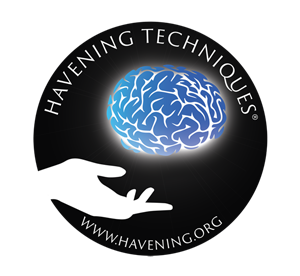
Havening Techniques®
What is Havening?
Havening Techniques® are a science-backed method, which is designed to change the brain to de-traumatize the memory and remove its negative effects from both our mind and body. As part of its protocol, it uses the sensory input of human touch as a therapeutic tool which we have identified as Havening Touch®. Physical touch increases the serotonin in the brain and reduces cortisol, which is known for creating a “fight or flight” response. These chemical changes play a direct role in your mood and how you cope with negative experiences.
The word Haven means ” a place of safety” and that’s exactly what this method does, it puts you in a safe place. The core of this technique is the touch: Therapeutically applied, gently stroking movements on the arms, on the palms and in the facial area. These movements generate delta waves in the brain and increases levels of seratonin. Seratonin helps stabolise moods.
These waves are associated with the deepest level of relaxation and restorative sleep. This touch can either be applied by the Practitioner, or the practitioner will guide you to perform this on yourself. The decision of who should provide the touch will be made jointly. Thanks to sound and standardized training, officially certified Practitioners are so experienced that they know exactly what speed and pressure are most useful in the process.
As well as touch it also incorporates distraction and eye movement.
The Havening Techniques® are powerful tools that can be used to treat the consequences of encoded traumatic or stressful memories. It works to interrupt the thought pattern in your amygdala, which is responsible for “fight, flight or freeze”. As well as using touch, and distractions such as imagining you are on a beach and counting out loud your steps as you purposefully walk along. Other distraction techniques are also used, as both the left and right brains are activated to help break the amygdala’s connection to the negative event.
The therapeutically applied, physical touch makes the subjective experience of receiving this method feel cathartic, liberating and soothing! Heart and soul feel refreshed, no matter what purpose you use it for.
Celebrity hypnotherapist, Paul Mckenna is a strong advocate for havening. Havening is NOT hypnotherapy.
What happens during a session?
During the session you will be asked to close your eyes and briefly recall the negative memory or the negative feeling, I will then gather some information from you if you wish to divulge. You will then be asked to clear your thoughts and focus on something positive and calming
You will then either have touch applied to you or you will be shown how to Self Haven, depending on your decision. You will be shown the various places where touch is applied, arms, hands and face. You will then be guided through a variety of distractions which include visualisation, counting, eye movement, and humming or singing simple songs such as “Happy birthday” or “Twinkle Twinkle”. During each step, you will be asked to assess your level of distress.
What are the benefits?
- Helps with anxiety, including GAD & social anxiety
- Removes phobias
- Changes how you perceive traumatic/distressing memories
- Reduces feelings of anger, cravings & panic attacks
- Works with PTSD & grief/loss
There are several different types of Havening and depending on what is discussed in the session will depend on the one used. Some of these are:
- Event havening – where we work on a specific event
- Transporational havening – this uses the emotional state that is created by the event
- Outcome havening – where the outcome of an event is changed. So imagining the event and how you would like it to be
- Affirmational havening – using words such as “I am…”. This is done to reinforce the positive and overlooked qualities we have
- Hopeful havening – this is most often done at the end of the session
- Ifformational havening – This is a way of tempting the mind into the direction of more helpful opportunities